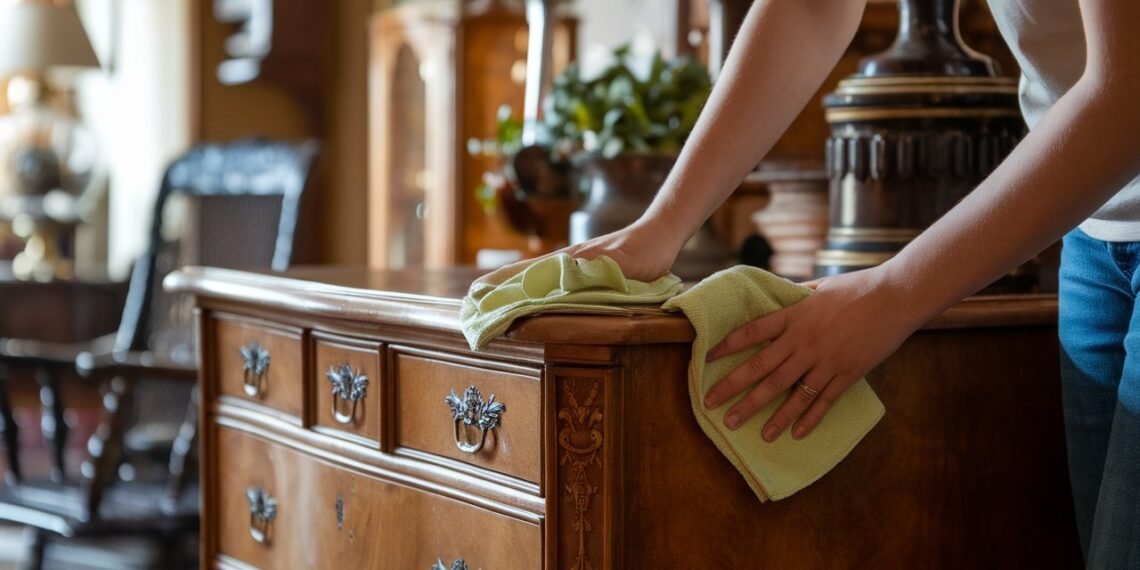Classic pieces have exquisite craftsmanship that modern furniture rarely matches. But preserving that timeless beauty and value requires thorough care. The patina, wear patterns, and hand-carved details that make antiques special also make them vulnerable.
That’s why understanding the materials, using appropriate cleaning methods, and controlling environmental factors are essential to extend your furniture’s longevity.
Here’s how to clean and protect your vintage pieces properly, so they remain beautiful and intact for generations to come.
Understand Material Composition Fully
The materials in antique furniture each have their own requirements, so knowing what you’re working with is the first step in proper care.
Cherry wood, for example, darkens with age and benefits from regular maintenance and protective coatings. Meanwhile, walnut responds well to the occasional touch of mineral oil.
Fabrics such as velvet or ornate textiles need gentle stain removal, but always test it on a hidden patch first. Leather has its own quirks too, requiring specialised treatments to stay supple and durable.
Other woods, such as oak and mahogany, respond differently to moisture and cleaning products, so a little research on each type goes a long way. Finishes such as shellac, lacquer, or wax may also need different approaches to avoid damage.
It’s important to understand existing finishes, as unknown varnishes may react badly to modern cleaners. So, when in doubt, seek expert advice.
Use Mild Cleaning Solutions
The cleaners you choose play a big role in keeping antique furniture safe. Go for gentle, earth-friendly cleaners that are kind to older surfaces. These won’t damage the wood or finishes that make your treasured pieces special.
Simple remedies often work best. A mix of white vinegar and water wipes wooden surfaces clean without leaving the sticky residue that many silicone-heavy polishes do.
It’s an easy, natural solution to include in your weekly house cleaning routine, to keep your furniture polished and well cared for.
Always test any cleaner on a hidden patch first—it’s the safest way to avoid nasty surprises. With this careful approach, you preserve both the beauty and longevity of your antiques.
Sometimes, old-fashioned concoctions outshine modern products, and as a bonus, they’re usually kinder on your wallet too.
For stubborn stains, dab gently with a soft cloth, and never scrub, as that can damage the finish. Use a soft-bristled brush to clean intricate carvings without scratching the wood. An old makeup brush or a clean paintbrush should work well.
Dust Your Furniture Gently
Regular dusting is your most important defence against damaging antique furniture. It may seem like a minor thing, but dust particles are surprisingly abrasive.
When allowed to accumulate, they gradually scratch delicate finishes, dull wood’s natural lustre, and trap moisture against surfaces. That trapped humidity can cause warping, discolouration, and even encourage mould growth in crevices.
Always use soft microfiber cloths rather than feather dusters, which simply redistribute dust instead of capturing it.
Work with the grain of the wood using gentle, smooth motions. For intricate carvings or detailed areas, a soft-bristle brush removes dust without scratching the vintage wood.
Dusting frequency depends on your environment. Homes near busy roads, rooms with frequently opened windows, and high-traffic areas accumulate dust faster.
Pets, forced-air heating systems, and seasonal pollen also increase buildup significantly. In such cases, you need weekly sessions instead of biweekly ones.
Light, frequent dusting prevents the stubborn buildup that eventually requires aggressive cleaning. That consistent, gentle care protects original finishes, preserves the wood’s patina, and maintains your antique’s value and beauty for generations.
Apply a Protective Coating
A well-chosen polish does more than shine. It nourishes the wood and shields it from moisture, stains, and daily wear. Natural beeswax or high-quality paste waxes are great options for antique finishes, offering protection without clogging delicate grains.
Apply a thin, even layer using a soft cloth, following the direction of the wood grain for a smooth finish. Avoid heavy coats, though. Too much polish traps dust and creates a cloudy surface over time.
Most antiques only need a proper polish two to four times a year, with light touch-ups in between.
Always allow each layer to dry fully before adding the next, and buff gently for a soft, lasting glow that highlights the intricate details.
Consider Environmental Effects
The location of your antiques plays a big role in how long they last. Prolonged sunlight can fade fabrics, dull finishes, and even cause wood to crack over time.
To prevent this, position furniture away from direct rays or use sheer curtains and blinds to filter the harsh light.
Your precious pieces shouldn’t sit near heaters or fireplaces either. Those temperature swings can do real damage over time. When you’re not showing off certain items, protective covers offer an extra shield against wear.
Humidity matters just as much as temperature. Aim to keep the levels steady between 40–60%. Too little moisture makes wood shrink and crack, while too much encourages swelling and loose joints.
Store Your Antiques Carefully
Proper storage is one of the most overlooked yet vital parts of preserving antiques. Keep both temperature and humidity steady to prevent cracking or warping, and cushion delicate edges or carvings with acid-free archival paper to guard against scratches and abrasion.
Use breathable covers instead of plastic, which traps moisture, and raise pieces off the floor to prevent heat transfer or water damage.
Before storing items for an extended period, clean and polish them thoroughly to remove any lingering dirt or residues.
You can also photograph and document existing marks or imperfections. This helps with insurance and allows you to monitor any changes over time.
With careful storage, your antiques can remain in excellent condition and emerge just as beautiful years later.
Repair Broken Pieces Promptly
Small issues can quickly escalate if ignored, so it’s best to address them as soon as they appear.
Regular inspections help you catch loose joints, hairline cracks, or signs of wear before they worsen.
Tighten screws carefully—there’s no need to force them—and use quality wood filler for small splits or chips.
Watch for signs of pests, like pin-sized holes or fine sawdust, which often point to wood-boring insects. Acting fast protects the rest of your collection and prevents costly restoration work later on.
If a repair feels a bit too adventurous, or you’re dealing with a prized piece, calling in a professional conservator is the smartest move.
Conclusion
With steady care and attention, your antique furniture can stay as elegant and enduring as the day it was crafted. Your pieces deserve that care, and the future generations will thank you for it.
Dust regularly, polish wisely, and handle every repair with patience and respect.
















